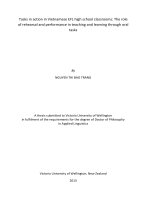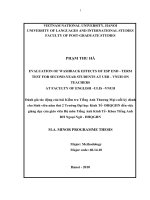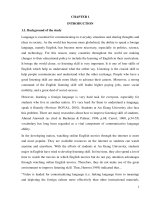Tóm tắt: Washback effects of highstakes English tests on Vietnamese EFL high school teachers’ teaching
Bạn đang xem bản rút gọn của tài liệu. Xem và tải ngay bản đầy đủ của tài liệu tại đây (496.71 KB, 29 trang )
<span class="text_page_counter">Trang 1</span><div class="page_container" data-page="1">
<b>HUE UNIVERSITY </b>
<b>UNIVERSITY OF FOREIGN LANGUAGES AND INTERNATIONAL STUDIES </b>
<b>TONG THI LAN CHI </b>
<b>WASHBACK EFFECTS OF HIGH-STAKES ENGLISH TESTS ON VIETNAMESE EFL HIGH SCHOOL </b>
<b>TEACHERS’ TEACHING </b>
<b>PHD THESIS SUMMARY IN THEORY AND METHODOLOGY OF ENGLISH LANGUAGE </b>
<b>TEACHING </b>
<b>Hue, 2024 </b>
<b>HUE, 2024 </b>
</div><span class="text_page_counter">Trang 2</span><div class="page_container" data-page="2"><b>HUE UNIVERSITY </b>
<b>UNIVERSITY OF FOREIGN LANGUAGES AND INTERNATIONAL STUDIES </b>
<b>TONG THI LAN CHI </b>
<b>WASHBACK EFFECTS OF HIGH-STAKES ENGLISH TESTS ON VIETNAMESE EFL HIGH SCHOOL </b>
<b>TEACHERS’ TEACHING </b>
<b>CODE: 9140111 </b>
<b>PHD THESIS SUMMARY IN THEORY AND METHODOLOGY OF ENGLISH LANGUAGE </b>
<b>TEACHING </b>
<b>Hue, 2024 </b>
</div><span class="text_page_counter">Trang 3</span><div class="page_container" data-page="3"><b>Hue University </b>
<b>Supervisor: Assoc. Prof. Pham Thi Hong Nhung </b>
</div><span class="text_page_counter">Trang 4</span><div class="page_container" data-page="4"><b>CHAPTER 1. INTRODUCTION 1.1. Background of the study </b>
In Vietnam, Ministry of Education and Training (MOET) oversees the nation's educational system, with a strong emphasis on general education, covering primary through high school levels. The Vietnamese educational system relies heavily on high-stakes tests, particularly evident in the National high school graduation exam (NHSGE), which all grade 12 students must take. These exams, apart from the Literature test, adhere to standardized testing principles, ensuring consistency in administration and scoring. The NHSGE tests students' proficiency in subjects such as Mathematics, Social Science or Natural Science, and Foreign Languages, highlighting their critical role in determining students' academic achievements and such future educational opportunities as university admission. The significance of these high-stakes tests is underscored by the attention they receive from various stakeholders, including students, teachers, administrators, parents, and policymakers, reflecting their integral role in the Vietnamese educational landscape.
<b>1.2. Rationale for the study </b>
In the domain of language education, testing and assessment play multifaceted roles beyond mere evaluation, shaping teaching methodologies, learning outcomes, decision-making processes, and employment prospects (Bachman &Palmer, 1996; Shohamy, 1998). Particularly, high-stakes tests wield significant influence in educational settings worldwide, including Vietnam, where they are pivotal in shaping critical
</div><span class="text_page_counter">Trang 5</span><div class="page_container" data-page="5">decisions concerning students and other stakeholders. The concept of washback effects, delineating the influences—be it positive or negative - of tests on various aspects of teaching and learning (Brown, 1997; Cheng, 1997; McKinley & Thompson, 2018; Nguyen, 2017; Pizarro, 2010), has emerged as a central theme in language testing discourse. Extensive research worldwide has explored the washback effects of various high-stakes English tests on stakeholders like teachers and students. However, there is a notable absence of research focusing on these effects within the Vietnamese context, especially in secondary education. While scholars such as Dinh (2020), Nguyen (2017), and Nguyen and Gu (2020) have examined these effects in higher education, there is a scarcity of research in secondary education settings. This research gap serves as the impetus for investigating the washback effects of a prominent high-stakes English test, namely the NHSGE English test, on Vietnamese high school teachers' teaching practices.
This study aims to identify washback factors to develop a conceptual framework that elucidates the mechanisms or interactions among these factors within Vietnam's centralized educational system. By undertaking this investigation, the study not only addresses theoretical gaps in the literature but also offers practical implications by understanding and mitigating potential negative washback effects. Ultimately, the findings of this research endeavor are anticipated to provide valuable insights for stakeholders aiming to enhance EFL teaching practices in Vietnamese high schools.
</div><span class="text_page_counter">Trang 6</span><div class="page_container" data-page="6"><b>1.3. Research question </b>
This study aims to examine the washback effects of the English tests administered as part of the NHSGE on the teaching practices of Vietnamese EFL high school teachers. Initially, the research aims to identify teacher-related factors as mediators of the NHSGE English test factors and contextual factors. After exploring these teacher-related factors, including demographic details, perceptions of contextual elements, attitudes towards the NHSGE English test, and perspectives on effective teaching and test preparation, the study shifts its focus to understanding the tangible effects of test-induced washback across various domains of EFL teaching. Specifically, the study seeks to address the following questions:
Question 1: What teacher factors are affected by the NHSGE English tests and related contextual factors?
Question 2: In what ways do the NHSGE English tests influence various aspects of EFL teaching?
<b>1.4. Scope of the study </b>
The current study delineates its scope by focusing on the English tests within the NHSGE framework, specifically excluding other high-stakes English tests, which are mandatory for Vietnamese grade 12 students. The investigation targets 58 Vietnamese high school teachers in Buon Ma Thuot city, Dak Lak province, Vietnam, who teach grade 12 students. It examines three key aspects of EFL teaching influenced by the NHSGE English tests: content coverage, instructional methods, and in-class assessment practices. The research site, Buon Ma Thuot city, situated in Dak Lak province, offers distinct ethnographic
</div><span class="text_page_counter">Trang 7</span><div class="page_container" data-page="7">characteristics that may affect teaching practices. Employing a mixed-methods approach, the study involves voluntary participation from EFL teachers. While the findings provide insights relevant to EFL teachers in similar ethnographic settings, caution is warranted in generalizing to all EFL teachers across Vietnam or other educational contexts. Instead, the study aims to enrich the literature by exploring various washback phenomena across different testing contexts, acknowledging the diverse nature of washback mechanisms.
<b>1.5. Significance of the study </b>
The study is of both theoretical and practical significance. Theoretically, it contributes by reviewing established washback models and constructing a comprehensive framework that examines the intricate interplay of various factors generating washback effects from the NHSGE English tests. Specifically, it identifies components of these washback factors and their impacts on different aspects of Vietnamese EFL teachers’ teaching practices. This enriches existing knowledge and provides insights transferable to similar educational contexts. Practically, the study sheds light on how NHSGE English tests influence the teaching practices of Vietnamese EFL teachers, encompassing what they teach, their instructional methods, and their in-class assessment strategies, all aimed at optimizing student learning outcomes. Additionally, the findings are valuable for EFL teachers, test writers, curriculum developers, and policymakers, guiding informed decisions on effective instructional methods, appropriate high-stakes test design, and the promotion or mitigation of both beneficial and
</div><span class="text_page_counter">Trang 8</span><div class="page_container" data-page="8">adverse washback effects, respectively. The study also lays groundwork for future research, exploring diverse effects teachers with different ethnographic backgrounds or investigate additional factors contributing to the washback mechanism There is also an opportunity to examine the broader washback effects of these tests on various stakeholders beyond teachers, including students, administrators, test designers, and curriculum developers in Vietnam.
<b>1.6. Structure of the study </b>
The study comprises five chapters, each serving a distinct purpose within the research framework.
<b>CHAPTER 2. LITERATURE REVIEW </b>
<b>2.1. Washback effects: definitions, dimensions, factors, and models </b>
There are six sub-dimensions within the concept of washback (Cheng & Watanabe, 2004; Xu & Liu, 2018).
<i>Washback specificity distinguishes between general effects </i>
applicable to any test and specific effects unique to a particular
<i>test or test type. Washback intentionality encompasses both </i>
intended effects foreseen by test designers, such as motivating learners and providing feedback, and unintended effects, like heightened anxiety and excessive focus on test-taking
<i>techniques. Washback length refers to the duration of </i>
test-induced effects, where certain impacts may persist over time,
<i>influencing students' habits of test preparation. Washback extent </i>
determines the range of influences exerted by tests, ranging from confined effects within a school context to nationwide influence
<i>for high-stakes tests. Washback intensity measures the degree of </i>
</div><span class="text_page_counter">Trang 9</span><div class="page_container" data-page="9">impact on specific areas of teaching and learning, with high-stakes tests exhibiting more pronounced effects compared to
<i>low-stakes ones. Washback direction refers to whether the impact of </i>
a test encourages or discourages the intended forms of teaching or learning, emphasizing its potential to be either beneficial or damaging. Washback is inherently neutral, capable of yielding positive or negative effects on individuals depending on the context.
Factors influencing test washback can be categorized into three subgroups: contextual factors (encompassing micro and macro contexts), test factors, and teacher factors. These main groups not only interact with one other but also exhibit interrelatedness among the specific factors within each subgroup in specific mechanisms and models to produce washback.
<b>2.2. EFL teaching: definition and aspects of teaching </b>
English as a Foreign Language (EFL) delineates the acquisition and utilization of the English language by individuals in a non-English-speaking environment.
The washback literature, exemplified by Alderson and Wall's (1993) hypothesis, emphasizes the multifaceted nature of teaching, encompassing what teachers teach and how they teach. Hughes (1994) further categorizes test effects into themes like participants, products, and process, with the latter including curriculum, methodology, and assessment. Hsu (2009) adds dimensions like instructional medium, teaching activities, and materials to the discussion. Empirical studies by Dinh (2020), Nguyen & Gu (2017), and Pizarro (2010) highlight diverse teaching aspects, including curriculum, materials, methods, and
</div><span class="text_page_counter">Trang 10</span><div class="page_container" data-page="10">teacher attitudes. Shih (2009) extends this by identifying four teaching domains influenced by tests, which include content, methods, assessment, and overall teaching style and atmosphere, and test-related activities and classroom atmosphere.
<b>2.3. Empirical research on washback of high-stakes tests </b>
Washback studies in language education have predominantly focused on teachers' instructional practices, revealing significant impacts on teaching content and curriculum. Adjustments influenced by high-stakes tests, such as the MET test in Li's (1990) study and the new O-Level exam in Sri Lanka (Alderson & Wall, 1993), emphasize practical language skills but raise concerns about curriculum narrowing. High-stakes tests also heavily influence the choice of teaching materials, leading to a reliance on exam preparation resources like textbooks, as highlighted in Lam's (1994) critique and studies by Andrews (1994), Aderson and Wall (1993), and Wall and Horak (2006). Besides, washback effects on classroom assessment, exemplified by Alderson and Wall's (1993) Sri Lankan study and Nguyen's (2017) research in Vietnam, underscore noticeable impacts on test design and diverse assessment types used by teachers. Variations in teaching methodology due to washback effects are evident, with studies by Barnes (2017), Shohamy et al. (1993, 1996), Stecher et al. (2004), and revealing nuanced differences in approaches to low-stakes and high-low-stakes exams.
</div><span class="text_page_counter">Trang 11</span><div class="page_container" data-page="11"><b>2.4. Conceptual framework for analyzing washback effects of the NHSGE English high-stakes tests on teaching </b>
<i> </i>
<i>Grid 2.5. Conceptual framework for the current study </i>
<b>CHAPTER 3. METHODOLOGY 3.1. Research design </b>
The mixed-method research approach with a two-phase explanatory design was selected for this study.
<b>3.2. Research settings and participants </b>
The research site selected is Buon Ma Thuot City, which situated in Dak Lak province in the Central Highlands of Vietnam and home to 12 public and three private high schools.
The research participants are 58 Vietnamese EFL high schools who are teaching English to 12<small>th</small> grade students in the research site.
</div><span class="text_page_counter">Trang 12</span><div class="page_container" data-page="12"><b>3.3. The researcher’s roles </b>
As the researcher for this study, I have extensive experience as an English lecturer at a university in Buon Ma Thuot city for over 20 years. Through my involvement in the university's English teacher training program and interaction with former students now working as EFL teachers in local high schools, I gained insights into their methodological knowledge, textbook usage, and lesson planning practices. Guiding fourth-year English teacher students during their internships further familiarized me with the educational contexts and characteristics of high schools in Buon Ma Thuot, the designated research site. Despite maintaining strong relationships with these teachers, which facilitated easy contact and willingness to engage in the study, there was a potential risk of hindering candid responses due to fear of judgment. To address this, I emphasized research purpose, outlined data collection procedures, and assured confidentiality, adhering to research ethics guidelines. Additionally, I remained mindful of my role as a researcher, ensuring adherence to rigorous data collection and analysis procedures to uphold study validity and reliability.
<b>3.4. Research instruments </b>
The instruments used to gather data on teacher factors and their teaching practices under the influence of the NHSGE English tests encompassed a questionnaire and follow-up in-depth interviews. Artifacts providing illustrations and supplementary information on teachers' teaching practices were also collected.
</div><span class="text_page_counter">Trang 13</span><div class="page_container" data-page="13"><b>3.5. Data gathering and analysis procedures </b>
<i>Grid 3.1. Stages For Data Gathering and Analysis </i>
<b>3.5. Validity and reliability </b>
In this study, various strategies have been employed to bolster both validity and reliability. Firstly, triangulation was utilized, incorporating data from questionnaires, interviews, and artifacts to cross-validate findings and ensure coherence across different data sources. Additionally, member checking was conducted, involving piloting of research instruments and meticulous verification of interview transcripts to enhance the credibility of the results. Oversight from the supervisor, with their expertise in mixed research methods, provided further validation. Methodological integration during data analysis facilitated a comprehensive understanding by merging quantitative and qualitative data. These measures collectively aimed to strengthen the study's validity and maintain the integrity of its findings. In addition, to ensure reliability, rigorous procedures were established for data collection and analysis, with
</div><span class="text_page_counter">Trang 14</span><div class="page_container" data-page="14">clear protocols communicated to participants in advance. The questionnaire items underwent transformation and analysis using SPSS software, aiding in achieving reliability. The Cronbach alpha coefficient for Likert scale items demonstrated satisfactory reliability, further affirming the study's dependability.
<b>3.6. Ethical concerns </b>
Oral consent was obtained from the EFL teachers, ensuring they were fully informed about the research objectives and their roles. Measures were taken to maintain confidentiality, with participants' identities protected through pseudonyms and careful handling of data. Transcripts were rigorously reviewed for accuracy, and efforts were made to build rapport with participants to encourage open communication. These ethical practices upheld the integrity and credibility of the study's findings while respecting the rights and privacy of participants.
<b>CHAPTER 4. FINDINGS AND DISCUSSION 4.1. The teacher factors contributing to the washback effects of the NHSGE English tests </b>
<i>4.1.1. The teachers’ perceptions of contextual factors </i>
The teachers in the study demonstrated a comprehensive understanding of the contextual factors, encompassing policies, guidelines, and instructions related to the NHSGE English tests and EFL teaching from various authorities. They also exhibited a strong awareness of their 12<small>th</small> grade students' interest in learning English and their competence. These findings are specific to the participants in the study and may influence their distinct teaching practices under the washback effects of the NHSGE English tests.
</div>








